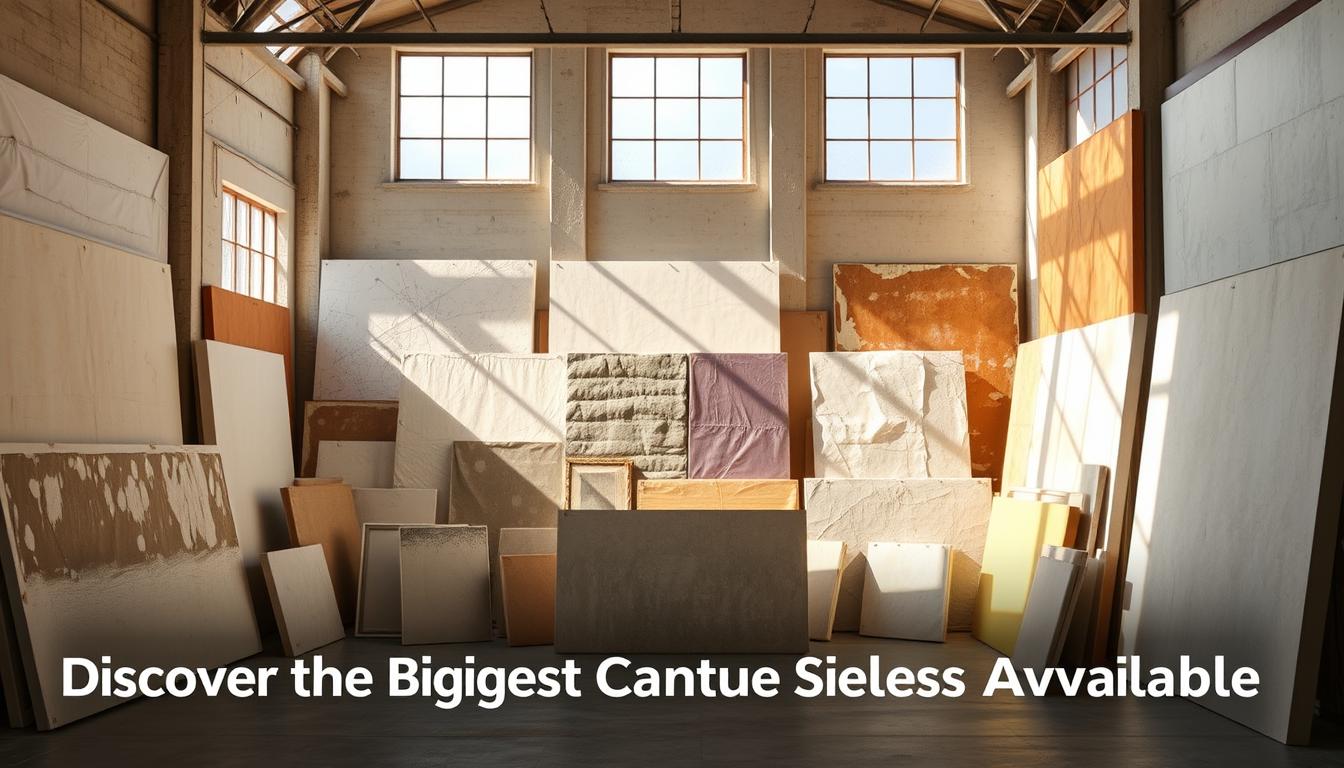Curious how far oversized art can go: could a wall be dominated by a single, dramatic piece?
Answering that question starts with inches. Commercially, stretched cotton and linen reach heights over 80", with common tall ranges at 72", 60–64", and 48–54". Brands such as Blick, Liquitex, Fredrix, Masterpiece, Old Holland, and Museo offer these options for large work.
Standard canvas sizes still matter for balance. Popular formats run from 8x10 and 11x14 up to 30x40 and 60x40, plus panoramics and squares. Choosing between cotton and linen affects weight, texture, and stability for bigger pieces.
For placement, aim for artwork that covers about 60–75% of a wall area or about 2/3–3/4 of furniture width when hung above sofas or consoles. To compare formats and measure your wall, see a helpful guide on common dimensions at standard canvas sizes and tips.

Key Takeaways
- Oversized stretched fabrics exceed 80" tall and are widely available from major brands.
- Standard and panoramic formats help scale prints and artwork to rooms and decor.
- Cotton is lighter and affordable; linen brings texture and strength for large pieces.
- Use 60–75% wall coverage or 2/3–3/4 of furniture width for balanced display.
- Measure, mock up with tape, and consider weight when choosing a right canvas.
What is the largest canvas size you can buy?
For rooms that demand a statement, extra-large stretched offerings bring scale and presence. Many commercial stretched options now span common tall ranges at 48–54", 60–64", 72", and beyond 80" in height. These dimensions give artists and decorators real flexibility for big walls and open space.
Defining “largest” in inches: from 60x40 to over 80-inch heights
Largest often means extra-tall stretched pieces that remain stable on a deep frame. Use 60x40 as a practical benchmark for dramatic impact without the delivery and hanging challenges of ultra-tall pieces. Custom builds extend past 80 inches when extra support and heavier weight are specified.
Where to find oversized canvases at Rossetti Art
Major suppliers — Blick, Fredrix, Masterpiece, Museo, Liquitex, Old Holland — offer wide-format stretched options. For a full comparison of dimensions and custom work, browse Rossetti Art to see the biggest canvas sizes and request tailored builds that fit your wall and delivery limits.
Material and build matter: cotton vs. linen, gallery wrap, and weight for stability
Cotton is lightweight and budget-friendly; linen gives a tighter weave and greater durability. Heavier weight and a tight weave improve stability for wide or tall pieces. A gallery wrap edge provides a finished look and may reduce the need for an external frame.
- Tip: Measure doorways and mounting points before ordering.
- Tip: For photo prints, use high-resolution files to avoid softness at large dimensions.
Standard canvas sizes vs. extra-large canvases: which size fits your wall space?
Choosing proportions helps art sit naturally in a room. Think in tiers: small to medium pieces for grouped layouts, larger formats for single anchors, and extra-large work for dramatic statements.
Small to medium sizes (10x8, 12x10, 16x12) work well in tight nooks and for a gallery wall. Use these in hallways, bathrooms, or clustered above a console to add interest without crowding walls.
Large pieces that act as a focal point
Step up to 20x16, 30x20, or 40x30 to make a clear focal point above sofas or beds. These sizes read well from across a room and pair nicely with furniture without overwhelming decor.
Extra-large and panoramic formats
For an extra-large statement, 60x40 or panoramic runs like 60x16, 10x30, and 40x10 spread impact horizontally. Panoramics suit long walls and open-plan spaces; tall or stacked layouts add vertical drama where ceilings permit.

| Tier | Common dimensions (inches) | Best use |
|---|---|---|
| Small to medium | 10x8, 12x10, 16x12 | Gallery wall clusters, entryways, tight spaces |
| Large | 20x16, 30x20, 40x30 | Main focal point above furniture, living rooms, bedrooms |
| Extra-large / Panoramic | 60x40, 60x16, 10x30, 40x10 | Single dramatic piece, long walls, open-plan areas |
| Square | 10x10, 20x20 | Symmetrical layouts, social media-ready prints, balanced gallery sets |
- Match aspect ratios (1:1, 2:3, 3:4, 4:5) to photos to avoid heavy cropping.
- Start with one main piece, then layer complementary canvases for rhythm and balance.
- For sizing guidance and common measurements, see a helpful guide to standard canvas sizes.
Buyer’s guide: how to find the perfect fit for your space, furniture, and photos
Begin with a quick wall audit: measure available width and height in inches, then run a simple calculation to narrow options. Multiply both numbers by 0.60 and 0.75 to get a target range that fills about 60–75% of your wall without overwhelming it.

Measure wall space: use the 60-75% rule to pick the right canvas size
Start by noting wall width and height. Multiply each by 0.60 and 0.75 to find minimum and maximum targets.
Example: an 80" wide by 36" tall wall gives a target near 48" x 27". That keeps the piece balanced and gives breathing room on each side.
Hang over furniture: aim for two-thirds to three-quarters of the furniture width
When placing art above sofas or consoles, pick a piece that spans about 2/3–3/4 of the furniture width. For an 84" sofa, that means roughly 56"–63" wide. A common 60x40 option often fits well in this role.
- Map a gallery wall first so combined canvases obey the 60–75% rule.
- Use high-resolution files for larger prints to avoid softness on big pieces.
- Choose a tighter weave or heavier weight for stability on extra-large formats.
Final step: once measured, browse Rossetti Art to find perfect options across standard canvas sizes and panoramic formats. Their selection makes it easy to order a perfect fit for your rooms and spaces.
Conclusion
, Finish by deciding whether a single statement or a grouped arrangement best suits the space.
Extra-large options include popular 60x40 formats and stretch past 80 inches in height for dramatic, room-defining pieces. Choose cotton or linen and a solid wrap to keep stability and finish right for your walls.
Use the 60–75% rule for wall coverage and aim for two-thirds to three-quarters of furniture width when hanging above sofas. That helps a piece read as a clear focal point without crowding decor.
Explore standard and extra-large canvas sizes at Rossetti Art to compare canvases, confirm measurements, and make a confident choice that transforms your wall into an elegant gallery part.
Enhance Your Space with Unique Modern Masterpieces by Chiara Rossetti
Are you inspired by the innovative mediums and conceptual depth highlighted in our exploration of contemporary art? You’re not alone! Today’s art enthusiasts are seeking cultural relevance and emotional connections in their artwork. However, finding pieces that resonate with modern themes and fit your unique style can be a challenge. That’s where we come in!
At Rossetti Art, we specialize in canvas prints, original paintings, and modern sculptures that celebrate the spirit of now. Each piece created by Chiara Rossetti brings a personal touch that connects deeply with current social narratives—just like the modern masterpieces discussed in the article. Don’t miss out on the chance to elevate your home decor with breathtaking artwork that speaks to your values and aesthetic. Explore our collection today and find your perfect piece! Act now, and transform your space into a gallery of inspiration!
FAQ
What counts as the biggest canvas available?
Many art suppliers and printers offer extremely large stretched panels and gallery wraps. Sizes commonly start around 60 x 40 inches and extend to 80-inch heights or wider panoramic formats. Custom shops and professional framer services can exceed those dimensions, producing pieces over 100 inches when wall structure and shipping logistics allow.
How do retailers like Rossetti Art handle oversized orders?
Specialty studios such as Rossetti Art typically offer custom printing, reinforced stretcher bars, and crating for safe transit. They advise on drywall anchoring, recommend linen or heavy cotton canvases, and often provide delivery and installation options for large pieces.
Does material choice affect stability for large pieces?
Yes. Linen and heavyweight cotton provide better tension and less sag than thin materials. Gallery-wrap construction with thicker stretcher bars and cross-bracing improves flatness. For very large works, consider plywood or aluminum composite panels for extra rigidity.
Which standard sizes work best for gallery walls and compact rooms?
Small to medium formats—8 x 10, 11 x 14, 16 x 20—inches fit tight spaces and groupings. These sizes allow flexible layout in salon-style arrangements without overwhelming furniture or wall trim.
What large sizes make a strong focal point in a room?
Traditional large choices such as 20 x 16, 30 x 20, and 40 x 30 inches command attention without dominating. For living rooms or entryways, 60 x 40 or similar panoramic formats create a bold centerpiece that anchors decor.
When should I pick square or panoramic aspect ratios?
Match art proportions to room geometry and furniture. Square canvases suit centered placements above mantels or sofas. Panoramic formats complement wide walls, sectional sofas, and hallways, maintaining balance with horizontal furniture.
How do I measure wall space to choose the right artwork dimensions?
Use the 60–75% rule: artwork width should cover roughly 60–75% of the furniture width beneath it. For empty walls, visualize coverage by marking tape on the wall to test different canvas widths and heights before ordering.
What spacing should I leave when hanging above furniture?
Aim for two-thirds to three-quarters of the furniture width for the artwork, and keep about 6–12 inches between the top of furniture and the bottom of the canvas. This creates a cohesive look while maintaining visual breathing room.






Leave a comment
This site is protected by hCaptcha and the hCaptcha Privacy Policy and Terms of Service apply.